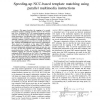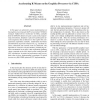1003 search results - page 93 / 201 » How to Parallelize Sequential Processes |
HPCA
2012
IEEE
12 years 4 months ago
2012
IEEE
Lowering supply voltage is one of the most effective techniques for reducing microprocessor power consumption. Unfortunately, at low voltages, chips are very sensitive to process ...
CAMP
2005
IEEE
14 years 2 months ago
2005
IEEE
— This paper describes the mapping of a recently introduced template matching algorithm based on the Normalized Cross Correlation (NCC) on a general purpose processor endowed wit...
IPPS
2008
IEEE
14 years 3 months ago
2008
IEEE
The increasing availability of multi-core and multiprocessor architectures provides new opportunities for improving the performance of many computer simulations. Markov Chain Mont...
PADS
1996
ACM
14 years 1 months ago
1996
ACM
One of the promises of parallelized discrete-event simulation is that it might provide significant speedups over sequential simulation. In reality, high performance cannot be achi...
INTENSIVE
2009
IEEE
14 years 3 months ago
2009
IEEE
In this paper an optimized k-means implementation on the graphics processing unit (GPU) is presented. NVIDIA’s Compute Unified Device Architecture (CUDA), available from the G8...


